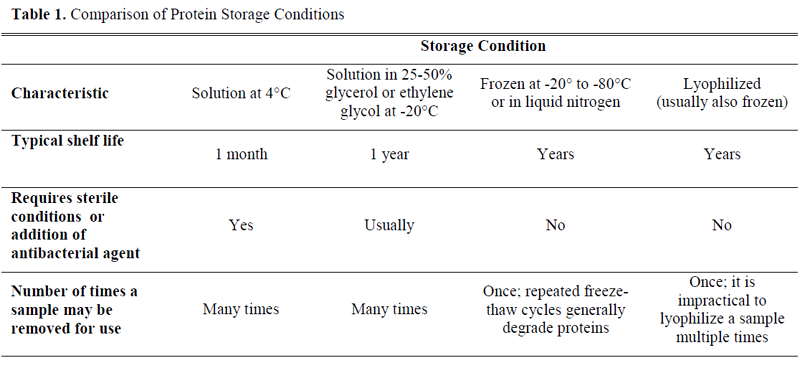- 2.PROTEIN PURIFICATION STORAGE OF PURIFIED PROTEINSFor short term storage (up to 24 h), most proteins can be kept at 4°C.
For storage times longer than 24 h at 4°C, it may be necessary to filter sterilize the protein preparation (through a 0.22 µm filter) or to add a bacteriostatic agent (e.g. 0.1% sodium azide) to avoid bacterial growth. Note that not all proteins are stable at 4°C for longer periods.
For long term storage (more than a week), it becomes necessary to freeze the protein preparation. It is important to freeze it rapidly using liquid nitrogen or a dry ice/ethanol mixture to avoid denaturation. It is also important to freeze the solution in small aliquots to avoid repeated freezing and thawing which may reduce the biological activity or affect the structure. Several stabilizing agents can be added, such as glycerol (5-50% (w/v)), serum albumin (10 mg/ml), reducing agents (such as 1 mM DTT), and ligands (the nature and concentration depending on the nature and concentration of the target protein).
If you want to store your protein preparation for several months, you can store it at -20°C. At this temperature it is necessary to add 50% glycerol to the solution to avoid freezing. The sample can be prepared in two ways:
- Add an equal volume of pure glycerol to the protein preparation.
- Dialyze the protein preparation against the storage buffer containing 50% glycerol. This method has the additional advantage that it results in an approx. threefold concentration.
If you need to store your protein preparation for longer periods (months to years), you should freeze it at -70°C or even in liquid nitrogen. Although it is not really necessary to add glycerol at these temperatures, the addition of 5-50% glycerol could help to keep the protein stable.
Alternative methods:
- Storage of the protein at 4°C as an ammonium sulfate precipitate.
- Storage of the protein at 4°C or lower in a lyophilized form. For the lyophilization it is necessary that the protein is dissolved in a volatile buffer (such as trimethylamine/HCl; pH range 6.8-8.8). Note that not all proteins are stable during the freeze-drying process.
- 位置
-
- 資料夾名稱
- Protein stability and storage (Pierce版本)
- 發表人
- 賴亮全
- 單位
- 賴亮全教授
- 建立
- 2019-01-03 21:41:49
- 最近修訂
- 2019-01-03 21:55:52
